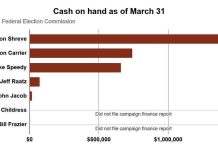Unlike four years ago, Mike Pence will launch his second campaign for governor June 18 with a record to run on.
Pence cited 110,000 net new jobs, falling unemployment, a growing labor force, the implementation of Healthy Indiana Plan 2.0 and rising graduation rates and test scores as examples of achieving progress for Hoosiers — all under his first term as governor.
“I’m very proud of that record,” Pence said Wednesday during a wide-ranging interview with The Republic’s editorial board.
Having defeated Democrat John Gregg four years ago by about 3 percentage points, Pence said whom he’s running against will not be a factor in determining his 2016 campaign strategy.
[sc:text-divider text-divider-title=”Story continues below gallery” ]
But political watchers can be assured that jobs will be a focus of the re-election campaign, Pence said.
He noted that Hoosiers are on pace to reach an all-time high for the number of them who are employed. As a first-time candidate for governor in 2012, the Columbus native said he wanted to see a record-breaking number of Hoosiers at work before he reapplied for the job of the state’s top executive. The state’s peak employment of 2,612,600 private-sector jobs was reached in March 2000. Pence said it’s likely that Indiana will hit that number this fall.
“We are 7,800 private-sector jobs away from having more Hoosiers go to work than ever before. We’re driving toward that in the policies we’re advancing,” he said.
While Indiana has been adding jobs, the state lags behind many others in per capita income, the Bureau of Economic Analysis reported in late March.
Indiana dropped from 38th to 39th in the nation, and its $39,433 per capita income is about 14.5 percent less than the national average of $46,129, the bureau reported. Personal income grew 2.5 percent from 2013 to 2014 — a growth rate better than only five states — when the national average was 3.9 percent.
As education improves and the skills gap narrows, Hoosier workers will have a greater opportunity to earn more money, Pence said.
“The most effective ways to raise incomes in the state of Indiana is to focus on education, particularly career and technical education, beginning in our high schools,” the governor said.
The next biennial budget includes $250 million — reflecting a $50 million increase — for high schools that offer career and technical courses in high-wage, high-demand areas, he said. High schools that graduate students with an industry certification or place them in areas of their concentration will receive bonuses, he said.
“Career and technical education is the key,” Pence said.
The state’s regional work councils have brought business and education leaders together to identify high-wage, high-demand jobs in their regions and are aligning education with the skills needed for those jobs.
“We have put into motion something that in three to five years could have a transformational effect on making sure that the high schools work just as well for kids who want to get a job as they do for kids that want to go on to school,” the governor said.
While educational attainment is important in improving Indiana’s per capita income, Pence said what often gets lost in that conversation is the state’s low cost of living.
“Indiana is a very attractive place to build a business and live and work,” he said.
Pence projected that Indiana would soon have one of the lowest corporate tax rates in the U.S.
The corporate tax rate drops from 7 percent to 6.5 percent on July 1. After several additional scheduled tax cuts, the corporate rate will drop to 4.9 percent in mid-2021. At that point, Indiana is expected to have the third-lowest corporate income tax rate in the nation, said Bridget Cleveland, deputy press secretary for Pence’s office.
A lower corporate tax rate would improve its attractiveness to investors, Pence said.
The notion of Indiana as a great place to do business was reinforced during economic mission trips to China and Japan, Pence said.
He led a May 11 to 16 delegation to China, including a stop at the Cummins-Foton engine-manufacturing facility in Beijing. He previously led a similar mission to Japan and will return there in the fall.
Pence said the advantages Indiana offers for businesses have helped establish a great track record of Asian companies investing in the state and Columbus, and he expects that to continue.
“We’ve got a couple of prospects right now we’re developing,” the governor said.
While on his first trip to China, Pence said, he learned about a growing interest in investment in the United States. Also, government officials and entrepreneurs are working with the United States on the Bilateral Investment Treaty, which would create a framework to encourage more foreign direct investment both ways, he said.
Indiana has about 300 Asian companies doing business in Indiana, of which about 250 are Japanese firms. Columbus has 24 Japanese-based companies, second in Indiana only to Indianapolis with 29.
Pence said former Gov. Robert Orr and former Columbus Mayor Robert Stewart laid the groundwork for Japanese companies to invest in Indiana and specifically in Columbus.
“They told the Indiana story,” Pence said.
The governor said that he learned from his economic mission trip to Japan that its companies have an affinity for the U.S. and Columbus because of a commonality of shared values and commitment to community that makes them feel at home.
Japan also has great traditions in agriculture and manufacturing, as does Indiana, he said.
“We continue to see a tremendous amount of interest and enthusiasm from our partners in Japan, and we’ll continue to encourage that in every way,” Pence said.
[sc:pullout-title pullout-title=”Gov. Mike Pence on key topics” ][sc:pullout-text-begin]
On his decision to seek re-election as governor:
“We put off a decision on our future until after the legislative session ended. That was more for me about focus. These annual biennial budget sessions are all-encompassing. … We always make these decisions as a family. … It was unanimous that we would seek re-election.”
On whether he will consider equal civil rights protections for the LGBT community in the next session of the Legislature:
“Two months ago the Legislature passed through the Religious Freedom Restoration Act, and I readily supported it. I strongly supported it, religious liberty. … The controversy and misunderstanding that followed the passage of that bill, I think, was deeply unfortunate. … I was pleased the Legislature passed the measure to clarify the intentions of the law … essentially the waters quieted fairly quickly after we signed the bill. … Decisions of what the next session of the Legislature will consider I think are the purview of the members of the General Assembly.”
On whether he supports adding protections for the LGBT community to the state’s civil rights statutes:
“Any discussion about that is a matter for the General Assembly to consider. That’s not been a priority for the people of Indiana in the past. Where I will stay focused is the agenda that I was elected to advance and, as I seek re-election, will continue to advance. That is an agenda that is really focused on jobs and schools and related to that workforce and health care in the state of Indiana.”
On the severity of Indiana’s HIV outbreak and the needle exchange program:
“I oppose needle exchange as anti-drug policy, and that continues to be my position. When the Centers for Disease Control (and Prevention) and my state Department of Health came to me and informed me as a matter of science we had an HIV epidemic in Scott County, I asked them ‘What do we need to do?’ They recommended a broad range of resources … but also said one of the ways we can get our arms around this is to create, essentially, a limited needle-exchange program, that would allow people to come out from the shadows. … I’m encouraged by the results. The number of new cases we’re finding is dropping off precipitously.”
On securing funds to improve Interstate 65 from Greenwood through southern Indiana:
“We’ve got $200 million in this budget for infrastructure. … I think infrastructure is second only to education in terms of importance to economic growth. … It’s all a work in progress. Everything is on the table for how we expand (interstate vehicle) capacity.”
[sc:pullout-text-end]




